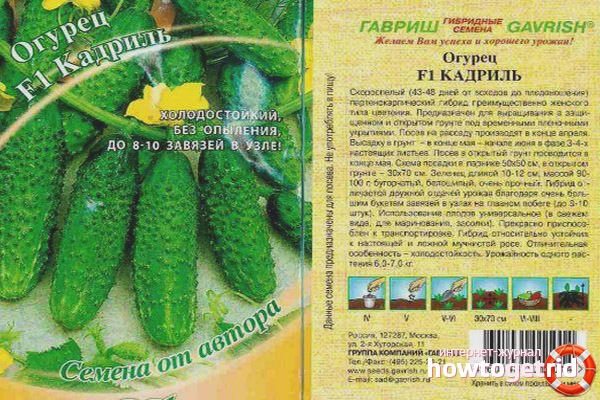The content of the article
Cadril cucumber belongs to the high-yielding hybrids. The main shoot of the plant has up to 10 bouquets with ovaries. This variety is distinguished by good immunity, it is not afraid of a sharp decrease in temperature, and its fruits tolerate long transportation well. These features have provided great popularity for the variety, which is growing every year.
Growing Features
Sowing hybrid seeds should be carried out at the end of April. Agronomists advise growing a variety of Cadril cucumbers by the method of preliminary germination of seeds, which is carried out according to the standard scheme:
- Seed disinfection. Purchased seeds are disinfected in a weak solution of manganese. The seed material is soaked in a solution, kept for no more than 1 hour, after which it is skipped and dried.
- Treatment with biostimulants. Growth biostimulants will help increase the percentage of seed germination.
- Soil selection. The soil for the germination of cucumbers The quadrille should be loose and nutritious.
- The choice of containers. Capacities for planting seeds of cucumbers should be easily separated from an earthen coma. It is possible to use thin pots for seedlings, which, if necessary, can be cut and gently separated from the root system of a young plant.
- Sowing. Seeds are placed in containers with soil to a depth of 1-2 cm.
- Greenhouse conditions. Before germination of the first shoots, the containers are covered with a dense film or glass.
Landing at a permanent place of growth is carried out in late May or in the first weeks of June. Transplantation is carried out by the transhipment method to minimize the risk of damage to the root system of a young plant. When planning planting bushes in open ground, it is necessary to take into account weather conditions. A hot, sunny day is not the right time to transplant cucumbers. It is better to transplant seedlings on a cool, cloudy day or in the evening.
After transplanting, young cucumbers are recommended to be watered and treated with biostimulants in order to reduce the risk of plant death and increase survival rate.
Quadrille Care
Caring for a hybrid Quadrille does not differ from the standard one and implies the following rules:
- Garter. Variety Quadrille is not distinguished by excessively long lashes. Despite this, the plant needs to be tied to a vertical support.
- Fertilizer application. Cucumbers need regular organic fertilizer. This will help the plant to form properly, provide an abundant appearance of female inflorescences and prevent the fall of unripe fruits.
- The formation of the bush. The bush needs proper formation. Failure to comply with this rule of cultivating a variety is fraught with a poor harvest.
- Watering. It is recommended to observe regular, plentiful watering with the settled water.
- Hilling. Hilling will prevent the death of roots that are on the surface of the earth.
- Weed removal. Weeding should be carried out regularly. Weeds, which have grown in the garden, are able to extract useful trace elements from the soil necessary for the proper growth of cucumbers, the formation of inflorescences and fruits.
- Timely harvesting. The ripened fruits that remain on the bushes interfere with the development of new inflorescences.
Experienced vegetable growers claim that with proper care, the cadril bush of Cadril variety has a dense and strong stem, a well-developed root system, and leaves of a bright green hue. Fruits warming on a strong plant have a rich shade of green.
Neighborhood with other cultures
During the distribution of space in the country, it is necessary to take into account the crops that are allowed to grow in the immediate vicinity of cucumbers:
- Greens.
- Garlic.
- Onion.
- Beets of any grade.
- Cabbage.
- Radish.
Positive grade characteristics

Cadril cucumbers are chosen by many experienced vegetable growers, noting a number of advantages of this hybrid:
- High yield. From one bush of cucumbers collect up to 8 kg of mature greenery.
- The average height of the plant. Not too large plants make gardeners easier to care for.
- The average level of leafyness. The foliage of the bush blocks the cucumbers from exposure to direct sunlight, but does not interfere with the harvest.
- Small size fruits. The weight of each cucumber does not exceed a mark of 100 g and a length of 13 cm.
- The first fruits are harvested 1.5-2 months after the germination of the first seedlings.
- Good plant immunity. Cadril variety is resistant to many diseases.
- Good taste. Cucumbers have a pleasant taste, without bitterness and third-party smacks.
- Appearance. Cadril cucumbers are distinguished by their marketable appearance, which makes it possible to grow this variety not only for home consumption, but also for sale.
- Good keeping quality. Cadril cucumbers are distinguished by their versatility. Mistresses use them to prepare fresh salads and preparations for the winter. Cucumbers canned both in whole and in chopped form.
Diseases
Despite the good immunity of the plant, agronomists recommend not to refuse regular treatments. Only they can fully protect the cucumber bushes from the development of dangerous diseases, and prevent the propagation of harmful microorganisms.
Cucumber Quadrille will delight any summer resident with a rich harvest. Even novice growers who have no experience in germinating and caring for this vegetable crop will be able to grow this variety in their beds and get a good harvest.
Video: Cadril F1 cucumbers










Submit